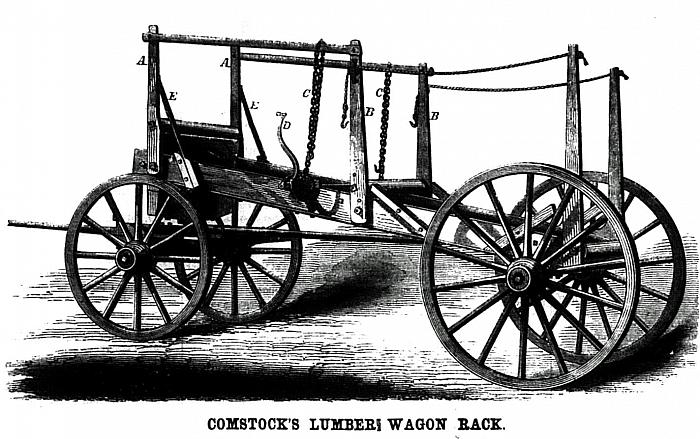Comstock's Lumber Wagon Rack
1867
"When drawing lumber on wagons for short distances the labor of loading and unloading takes more time than to convey the load. Two men are necessary to load and to unload; one must be on the team and one on the ground. The employment of a roller near the driver’s seat and one at the rear of the wagon at different elevations to give the load a backward incline is often used, but the binding of the load, its unbinding, and discharge still required considerable time and labor.
In the rack represented in the engraving the body of the wagon is inclined by means of bolsters of differing heights, that on the forward end being the highest. The upright stakes are pivoted to the sides of the frame and in them turn the pivots of the rollers. The uprights, A and B, are connected together by pivoted bars at their top so that they move in unison, and the rear uprights my be connected to B by lines which pass over pulleys on B, or through staples, and from these they can be attached to the chains, C, which are intended to be wound up on the shaft forward of the stakes, B, which shaft is turned by the crank, D, and held in position by the ratchet and pawl seen in the engraving. By a forward movement of the uprights, A and B, and backward of the rear stakes the rollers are lifted from the bolsters and allowed to turn free, which assists in the process of loading. This position of the stakes and rollers is assured by hooking the hooks of the lines into the chains, C, and turning the crank, D. This compels the rollers to bear the weight of the load. The diagonally affixed pieces on the sides of the wagon near the middle and rear uprights, prevent them from moving back too far when the rollers are raised. The pivots of the stakes, A and B, are in the rear of those of their respective rollers, and those of the rear stakes are forward of those of that roller. This gives an eccentric motion, which insures the raising of the rollers and also their easy seating on the bolsters to prevent their turning."
Text and image from Scientific American, May 4, 1867, page 284
Subjects
Full Details
| Title | Comstock's Lumber Wagon Rack |
|---|---|
| Date | 1867 |
| Format | Illustration |
| Notes | "Comstock’s Patent Lumber Rack seems to be one of the most valuable and useful labor-saving inventions of the day. It is claimed that by its use one man can easily perform as much work as two would by the ordinary method. Its chief peculiarity consists in the fact that by a simple contrivance a load of lumber whether long or short, may be instantaneously unloaded or “dumped” upon the ground in a compact pile. It is the invention of Mr. C.C. Comstock of Grand Rapids, Mich., formerly a resident of this county. His brother, Mr. D.W. Comstock of this town, has a model of the rack, which he will be pleased to show to all who desire to see and understand its operation." New Hampshire Sentinal, February 13, 1869 |
| Location In Photo | Grand Rapids MI |

